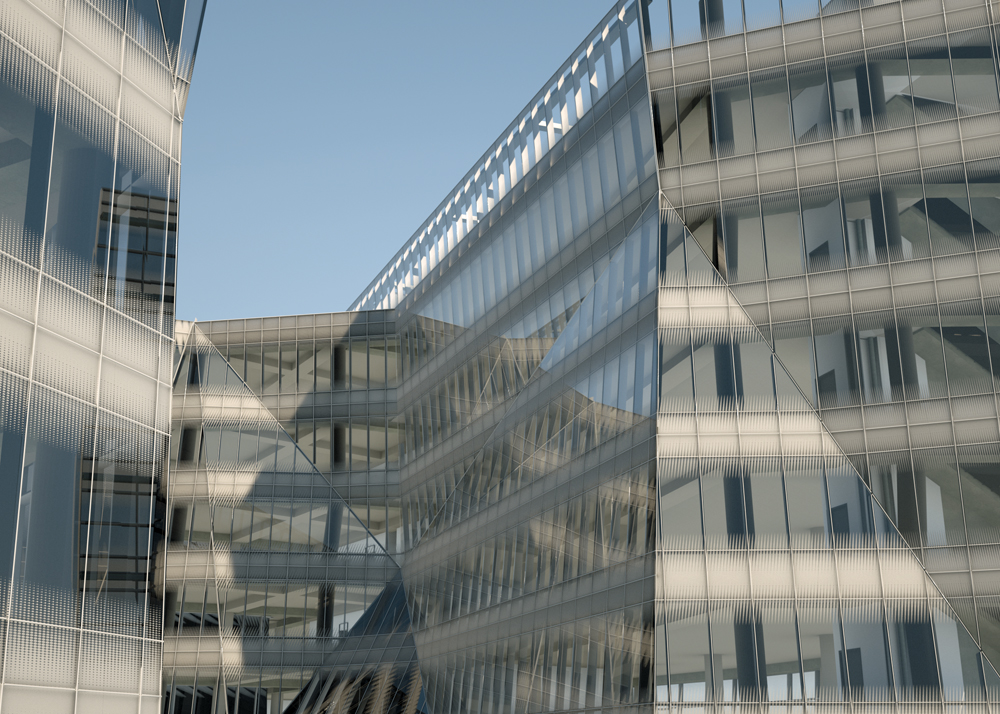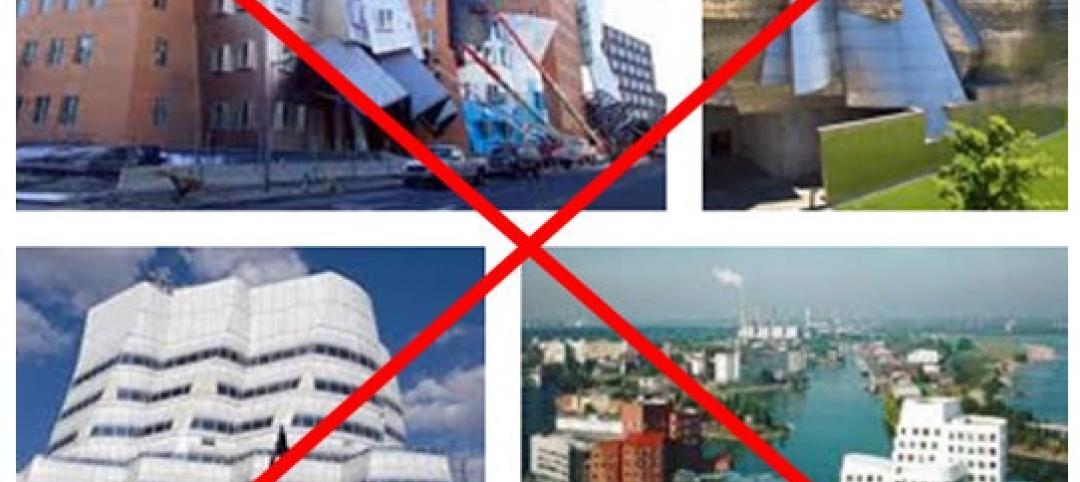Seven seconds. That is all it took for Gensler’s Mark Bassett to generate a geometrically accurate, photorealistic rendering from one of the firm’s Revit models. The colors popped. The lighting and shading were spot on. The materials, finishes, fixtures, and furnishings were precisely represented. There was no need for touch-ups using Photoshop, or tweaks in 3ds Max. Just a few clicks of the mouse and voilà!—a professional-level 3D rendering appeared on Bassett’s monitor.
Creating and refining renderings using traditional methods can be an arduous task, requiring several hours of work by a designer or thousands of dollars in outsourcing costs (and a 24-hour turnaround) to a rendering specialist. Bassett thought there had to be a better way.
A trained architect who is a whiz with computers, Bassett began his career as an architect and eventually transitioned to computer programming, joining the original Revit startup. Following the acquisition by Autodesk, he moved to the AEC side of the business, where he has spent the better part of the past decade helping Gensler integrate BIM tools and streamline project workflows using technology—in addition to practicing architecture.
One of his recent crusades is developing a simple process for creating high-quality renderings on the fly. The growth of BIM and 3D rendering technology, he says, has raised client expectations and placed additional pressure on the Building Team to produce visually striking artwork that accurately depicts the very latest iteration of a project’s design. No longer can renderings be simply representative of the design scheme. And turnaround time on artwork has to be in hours, not days or weeks.
“We’re getting to the point where even 24 hours isn’t fast enough,” says Bassett. “The deliverables are continuing to be requested at a faster speed.”
THE RISE OF GPU COMPUTING
To find a solution, Bassett turned to the gaming and moviemaking industries, where he learned of a newly developed software tool, called Octane Render, capable of processing photorealistic renderings 50 times faster than Gensler’s current methods.
Developed by Los Angeles-based cloud rendering company Otoy, Octane Render is part of a new breed of ultra-high-speed rendering applications that utilize GPU-accelerated computing methods popularized by the gaming industry. Instead of processing images using a computer’s CPU, Octane Render uses the machine’s graphics processing unit, together with the CPU, to greatly accelerate processing speeds. The results are dramatic, says Bassett.

By implementing Octane Render, Gensler has been able to reduce its render time to minutes versus hours. On the firm’s trial project with the software, architect Rosario Li Rocchi rendered the lobby of a government office project in just 10 minutes, including initial render creation, material selection, and final render output. Using the firm’s traditional methods (SketchUp and V-Ray), the same process took four hours. RENDERINGS: GENSLER
“To put it into perspective, when Pixar was developing the movie ‘Cars 2,’ its average rendering time per frame was 11.5 hours,” says Bassett. “We’re rendering at seven seconds a frame using Octane. It changes everything. There are now Hollywood movies being made using this technology.”
The results were as equally impressive on Gensler’s trial project with the software. Gensler architect Rosario Li Rocchi rendered the lobby design of a government office project in Washington, D.C.—first using the firm’s traditional process (export data from Revit into SketchUp for material and lighting assignments, and then render in V-Ray), then using Octane Render. The total production time was reduced from four hours to just 10 minutes. Best of all, says Bassett, Rocchi needed less than 10 minutes of one-on-one training to pick up the new software. For designers with little or no computer rendering experience, the learning curve is a bit steeper, but still less than a few hours, he says.
“The beauty of this software is that it’s extraordinarily easy to use,” says Bassett. “People who have never rendered before are producing acceptable results after just a couple hours of play.”
Gensler is the first U.S.-based AEC firm to implement the software program on a large scale. The firm owns 35 seats, and every office has at least one Octane-optimized workstation. At $250 a seat, the software is relatively affordable, and it doesn’t require a supercharged workstation to process renderings.
“Most of the new hardware we’re buying right now will run Octane,” says Bassett. “We have a few people with copies on their laptops, and they’re able to render at much faster speeds. Of course, with the optimized machines, the render speed is almost real time.”
TURNING ARCHITECTS INTO MOVIE DIRECTORS
Ultimately, Bassett sees Octane Render as a way for Gensler’s designers to add value to projects—not just through renderings, but also short movie clips of their design schemes. His goal: make it easy for designers unfamiliar with advanced rendering and character animation to create 30-second movie clips with camera and character animation in less than an hour.
Currently, animations are cost-prohibitive (running upwards of $15,000 in outsourcing costs for a well-executed 60-second clip), and the results are hardly ever impressive. “Animations are particularly problematic,” says Bassett. “We currently subcontract this work out, where a minute of ‘good’ quality video is still no match for Hollywood standards.”
This 23-second movie clip was produced by Gensler designers in about an hour using Octane Render. It is illuminated by sunlight, seven artificial lights, plus a light box wall with an illuminated image, all taxing on a renderer, according to Gensler's Mark Bassett.
To help his colleagues bring their designs to life through high-speed renderings and movie-like animations, Bassett wrote two custom scripts for Octane. The first is a Revit-to-Octane exporter that transfers all Revit geometry and materials directly into Octane, enabling near-real-time rendering creation straight from the BIM file.
The second runs within Octane and allows the software to render a series of frames directly from a BIM model, sequenced so that they can easily be turned into video using Windows Movie Maker. Bassett took cues from traditional moviemaking when writing this application. Instead of applying traditional computer graphics techniques found in most software tools, he modeled the script based on analogue camera manipulation techniques. As a result, users have the ability to move the camera through space, rotate and tilt from a single location, zoom in and out, and even clip scenes. Camera motion blur is also possible, as is animating the suns path through the sky.
“The user creates a series of compound camera moves—for example, zoom in while orbiting 90 degrees left—that are concatenated to make a movie,” says Bassett. “The sequence of moves can be saved to disk and reloaded for playback in Octane at a later date.” In this way, movie direction can precede the completion of the modeling activities, compressing the traditional critical path relationship between modeling and animation.

This façade rendering was generated straight from a Revit model in several minutes using Octane Render. Gensler is the first U.S.-based AEC firm to implement the software program on a large scale. The firm owns 35 seats, and every office has at least one Octane-optimized workstation. RENDERINGS: GENSLER
The final piece of the puzzle, which is still in the works, is assembling a library of Octane-ready animated assets (people, cars, trees, water, etc.) that can be dragged and dropped into movies to liven things up. These assets can be purchased commercially or produced in-house.
“It will enable staff to add motion to elements in the scene so that the video is not limited to wandering around a static model,” says Bassett. “It is this capability that differentiates the higher-end animations, and that adds significant additional cost.”
EARLY SUCCESS STORY
Jared Krieger, AIA, LEED AP, a Project Architect in Gensler's Washington, D.C., office, was one of the firm's first Octane users. He offers a story of how the software tool helped secure a new client:
"Speed and process are really important to our clients, especially when we get into larger global accounts. We were recently asked while competing for a relationship why it would be different to work with Gensler. In a meeting, we gave them a simulation of how we are starting to reinvent our process using Octane. We showed them how we can pan around the model while the computer almost simultaneously renders the view. And how we can make a tweak and quickly re-render almost seamlessly. They were turned on to the collaborative nature of the design process and our use of technology to assist. This was a huge win for us."
Related Stories
| May 10, 2011
Dinner is now served…atop the Lincoln Memorial?
Take a look at the temporary restaurant sitting atop Brussels’ historic Arc de Triomphe-Triomfboog. The Cube, by Electrolux, offers 18 diners a spectacular view of the Parc du Cinquantenair, and is one of two structures traveling across Europe, making stops at famous landmarks in Belgium, Italy, Switzerland, Sweden, and Russia. What do you think about one of these 60-tonne structures being placed on a U.S. memorial?
| May 6, 2011
Ellerbe Becket now operating as AECOM
*/ The architecture, interiors and engineering firm Ellerbe Becket, which joined AECOM in 2009, has fully transitioned to operating as AECOM as of May 2, 2011.
| May 2, 2011
URS acquires Apptis Holdings, a federal IT service provider
SAN FRANCISCO, CA and CHANTILLY, VA– April 28, 2011 – URS Corporation and Apptis Holdings, Inc., a leading provider of information technology and communications services to the federal government, announced that they have signed a definitive agreement under which URS will acquire Apptis.
| May 2, 2011
Perkins+Will merges with Vermeulen Hind Architects, offically launches Perkins+Will Canada
Ottawa and Hamilton-based Vermeulen Hind Architects, one of Canada’s leading healthcare architectural firms, has merged with Perkins+Will. Vermeulen Hind joins Toronto-based Shore Tilbe Perkins+Will and Vancouver-based Busby Perkins+Will to create Perkins+Will Canada. The combination marks the official launch of Perkins+Will Canada, a merge that will establish the firm as among the pre-eminent interdisciplinary design practices in Canada.
| Apr 26, 2011
Ed Mazria on how NYC can achieve carbon neutrality in buildings by 2030
The New York Chapter of the American Institute of Architects invited Mr. Mazria to present a keynote lecture to launch its 2030 training program. In advance of that lecture, Jacob Slevin, co-founder of DesignerPages.com and a contributor to The Huffington Post, interviewed Mazria about creating a sustainable vision for the future and how New York City's architects and designers can rise to the occasion.
| Apr 26, 2011
Video: Are China's ghost cities a bubble waiting to burst?
It's estimated that 10 new cities are being built in China every year, but many are virtually deserted. Retail space remains empty and hundreds of apartments are vacant, but the Chinese government is more concerned with maintaining economic growth—and building cities is one way of achieving that goal.
| Apr 25, 2011
Earn $300 million by NOT hiring Frank Gehry
An Iowa philanthropist and architecture aficionado—who wishes to remain anonymous—is offering a $300 million “reward” to any city anywhere in the world that’s brave enough to hire someone other than Frank Gehry to design its new art museum.
| Apr 20, 2011
Marketing firm Funtion: to host “Construct. Build. Evolve.”
Function:, an integrated marketing agency that specializes in reaching the architecture, building and design community, is hosting an interactive art event, “Construct. Build. Evolve.” in Atlanta’s Piedmont Park on Thursday April 21, 2011 at 11:00AM EDT. During the event attendees will be asked to answer the question, “how would you build the future?” to rouse dialogue and discover fresh ideas for the future of the built environment.
| Apr 20, 2011
Architecture Billings Index: new projects inquiry index up significantly from February
The American Institute of Architects (AIA) reported the March ABI score was 50.5, a negligible decrease from a reading of 50.6 the previous month. This score reflects a modest increase in demand for design services (any score above 50 indicates an increase in billings). The new projects inquiry index was 58.7, up significantly from a mark of 56.4 in February.











